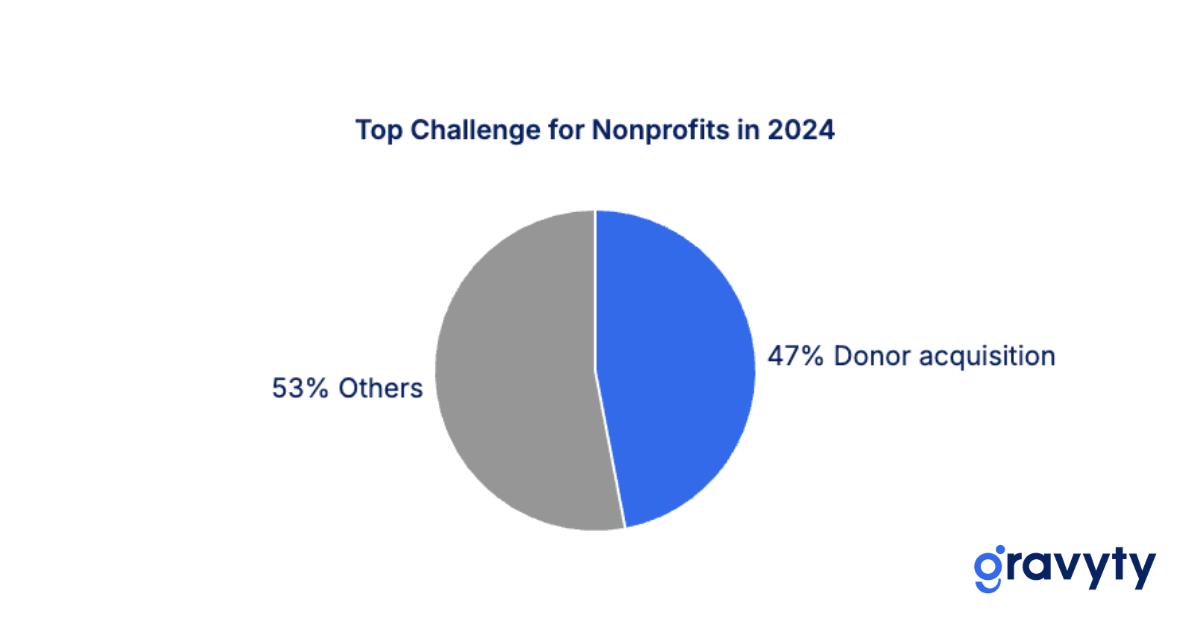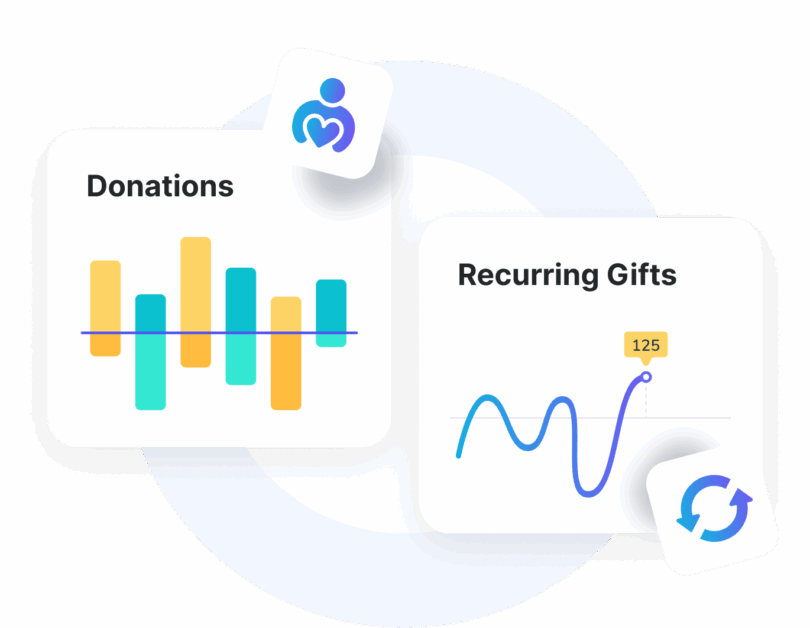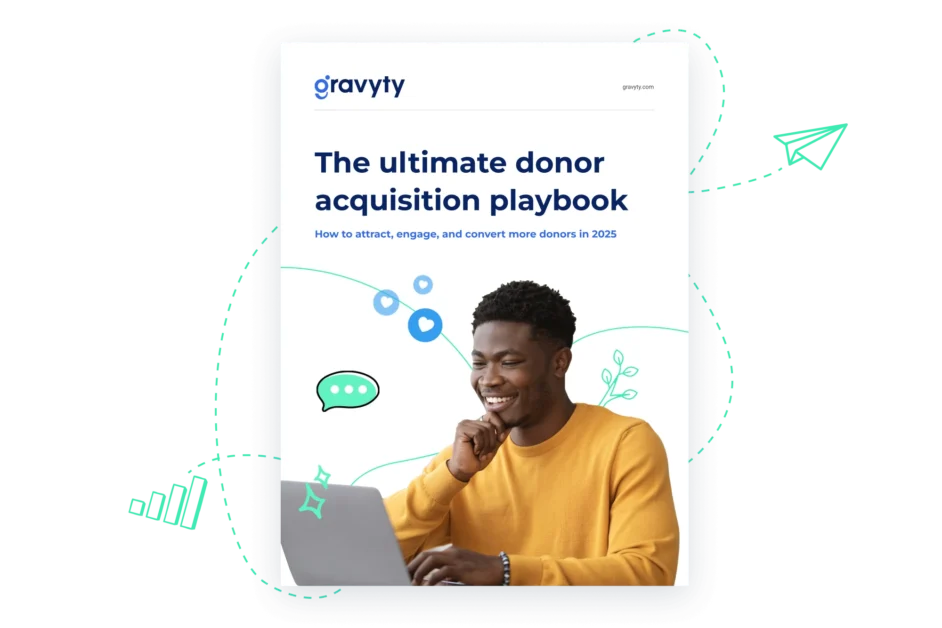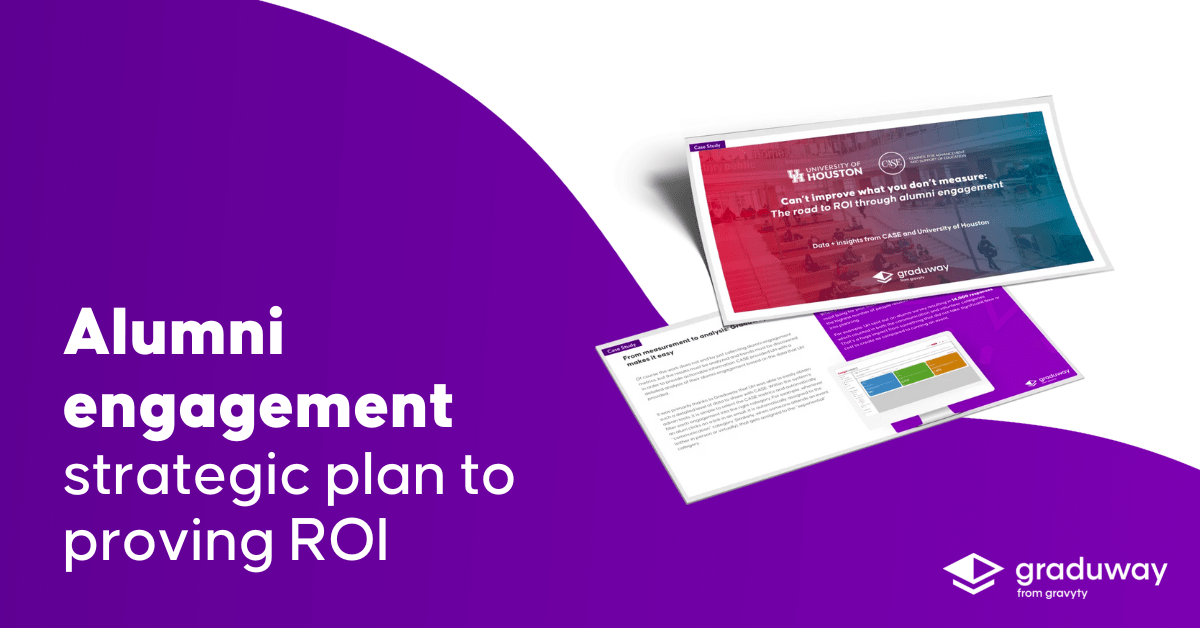Data-driven donor acquisition strategies for the full donor life cycle

In higher education, attracting new donors is consistently cited as a major hurdle. In fact, 70% of organizations recently surveyed said donor acquisition or retention are top challenge. Another industry study found donor acquisition emerged as the top challenge heading into 2025, with 47% of nonprofit leaders identifying it as their primary hurdle for the year.
This focus on acquisition is driven by real-world trends: even as some nonprofits raised more money, the number of donors declined by 1.3% year-over-year, and donor retention rates slipped from 18.3% in 2024 to 18.1% in Q1 2025. In other words, nonprofits are seeing donor counts shrink and struggling to hang on to supporters with only 50% of organizations retaining half their new donors, making a smart acquisition strategy more critical than ever.
Acquisition and retention go hand in hand. Effective planning must serve a dual purpose, focusing on bringing in new donors while, at the same time, fostering long-term relationships. The goal should be to foster a loyal donor base rather than secure one-time gifts.
The following strategies cover each stage of the donor lifecycle, everything from initial targeting and cultivation to sustained engagement, to help your organization acquire supporters and set them on a path to longer-lasting commitment.

Mapping your donor landscape: Data-driven targeting & segmentation
A strong acquisition strategy begins with understanding your institution’s fundraising history. Review donor patterns over the past 3–5 years: When did new donor numbers rise or fall? Which campaigns brought in the most prospects?
Grounding your approach in real trends—rather than assumptions—helps ensure relevance. As one fundraising firm put it, “the first step to developing a strong strategy around acquisition and retention is to understand your own organization’s shifting trends.” By analyzing retention and acquisition data, you can identify what drives results and adjust accordingly.
Audience segmentation is critically important in these initial stages. Rather than casting a wide net and trying to target everyone with a single approach, focus on groups that align with your mission. Young alumni, first-time event attendees, or lapsed donors are all excellent examples of smart segmentation.
The ultimate donor acquisition playbook
This playbook walks you through a 6-step strategy that helps you connect with the right people, deliver relevant outreach, and guide donors from first gift to lifelong support.
What’s inside:
- Breakdown of the donor development cycle
- Ways to move beyond transactional outreach into relationship-first strategies
- Reflection prompts to align your team around what works
Segmenting helps you personalize messaging and identify the right mix of right channels to speak to them most effectively. A $20 donor you identified from social media won’t respond in the same way as someone who responded to direct mail. By understanding each group’s engagement style, you can reach them more effectively.
Data-driven targeting extends well beyond your donor list. External data and technology both have the ability to identify new prospects. Prospect researching services and predictive analytics can flag individuals who resemble your best donors or show capacity and interest.
Social platforms help target look-alike audiences and people interested in causes related to your mission. For example, a healthcare nonprofit could reach those engaged with surrounding health topics in addition to directly addressing donor lookalikes.
Predictive insights like these help prioritize outreach to those most likely to give, combining observed donor trends with external analytics to maximize the impact of your acquisition efforts.
Relationships first, donations second: Cultivating new donors
Acquiring a donor is only the start. To turn prospects into repeat supporters, focus on building relationships before making an ask. Donors are more likely to give when they feel connected to your mission, yet 56% of nonprofits lack a formal engagement strategy.
Skipping this step risks losing trust and rapport. Instead, nurture prospects with pre-ask touchpoints like welcome emails, newsletters, social interactions, or event invites. For example, a new alumni lead might first receive success stories and an invite to a virtual campus tour, laying the groundwork for a more receptive response when the donation appeal arrives.
Storytelling is one of the strongest cultivation tools. Sharing narratives about the people, programs, or communities you serve shows donors the impact of their support and inspires them to join the story. Transparent reporting builds trust with 59% of people saying they trust nonprofits more when organizations share clear results of their work. Going beyond one-time appeals, nonprofits should consistently ask, thank, and report back to deepen relationships. After a first gift, follow up with a thank-you. Come back later and share how the funds were used. Invite them to a behind-the-scenes webinar to keep them engaged.
The YMCA Blue Ridge Assembly used video storytelling to raise over 2.5 million for areas impacted by a flood, illustrating how the personal connection makes the difference in results.
Meet donors where they are: Multi-channel outreach
Donor acquisition is most effective with a multi-channel approach. Relying on just one or two approach or media source risks missed opportunities. As one expert notes, “No more relying on just one or two platforms—we’re going where your donors are and bringing fresh, meaningful content with us.”
Combining multiple communication channels is key, including email, social, direct mail, phone, text, and events. This muti-faceted approach ensures you meet your donors where they are. Different people and communities often prefer very different media. Repeated exposure across channels reinforces your cause.
As reported by Nonprofit Pro, texts have a 99% open rate, while social posts reach audiences who may ignore email entirely. By using these different channels together, you can keep your mission top-of-mind.
Multi-channel outreach isn’t a shotgun. A proper multi-channel approach is about integration and consistency. Each channel should work together to tell a unified story and reinforce one another.
Coordinate the timing so a prospect sees a mailer, email, and social post about the same campaign at the same time.
Launch with an email, build momentum with a social challenge, and then send a text reminder as deadlines near. This kind of messaging consistency prevents conflicting messages and creates a seamless donor experience.
Far from a fringe theory, this multi-channel approach is widely supported, with 2025 engagement channel trends showing much more diversity in marketing efforts.
Use data to guide your channel strategy. Track response rates to see which efforts convert and which underperform. For example, direct mail may yield strong results for one nonprofit while another finds greater success digitally.
CCS Fundraising
Let evidence shape budget and effort: invest more in high-performing channels, cut back on weak ones, and refine continually for maximum donor reach.
Embracing technology: AI and automation for smarter donor acquisition
Fast-growing technologies like AI and deep automation are reshaping donor acquisition landscape significantly. Nearly half of fundraisers (47%) see AI as 2025’s top digital opportunity. AI often excels at prospect identification and finding patterns in your donor data. Predictive tools assess a range of behaviors to score prospects, letting nonprofits focus on where returns are most likely.
This can improve ROI and boost revenue. Modeling might show that lapsed donors who volunteer are strong candidates for re-engagement, providing a focus for targeted campaigns. In short, AI helps nonprofits work smarter by prioritizing the right individuals.

The swift emergence of wide-scale automation is transforming donor acquisition by allowing personalized outreach at scale. Many modern platforms, often AI-powered, allow nonprofits to engage thousands of prospects much more efficiently.
You can automate everything from welcome emails, social posts, or SMS reminders based on potential donor behavior, and you can do it while keeping those communications personal.
AI and automation can supercharge donor acquisition, absolutely. But it’s extremely important to remember that they are tools to assist fundraisers, not replace them. As one consultancy noted:
BWF
The most critical human elements, building trust, telling stories, showing empathy, remain essential. Technology handles data analysis and routine tasks, freeing staff to focus on emotional connections and strategy.
Measuring success and adapting
No donor acquisition plan is complete without measuring success. All too often, nonprofits launch initiatives with no clear goals. A lack of clear goals makes it difficult, if not impossible, to know what works and what doesn’t.
Start by setting measurable targets. Define KPIs like new donors per month, campaign conversion rates, average gift size, and cost per acquisition. As CCS Fundraising advises, “lay out clear and measurable goals… and be prepared to be agile.” Revisit goals often, adjusting strategy if results fall short, to stay focused and accountable.
The next step is to put systems in place to continuously track and analyze your results. Every single acquisition effort should be followed with a simple question:
How did we do?
Capture data across channels: email platforms for open rates, CRMs for sources, and analytics for traffic and tracking sign-ups. Reviewing regularly reveals what’s working and what needs attention and improvement. As reported in NumberAnalytics, by tracking key metrics and analyzing your data, you can identify areas for improvement and make data-driven decisions. Let real data drive strategic pivots and investments.
Treat your organization’s acquisition strategy as a continuous learning process. This isn’t set-it-and-forget-it. Build an ongoing feedback loop:
- Plan
- Execute
- Measure
- Learn
- Adjust
- Repeat
Test approaches with A/B welcome emails or small-scale peer-to-peer campaigns, refine your messaging based on results, and expand on what works.
As Nonprofit Tech for Good highlights, fundraising success comes from being intentional and thoughtful at every step of the process. Having regular evaluations helps ensure you’re targeting the right audiences, refining messaging, and adapting quickly.
Donor retention starts on day one
he most important day in any donor’s journey is what happens immediately after their first gift. Retention efforts begin immediately with prompt, personal thank yous and follow-up touches. A responsive, personalized, and welcoming stewardship plan shows donors they matter. This strengthens engagement and greatly increases the chances of future giving.
Retaining donors is far, far more cost-effective than finding new ones. Nonprofits spend about $1.50 per $1 raised to acquire a new donor but only $0.20 to retain one. This cost difference makes donor retention a much stronger long-term investment. Don’t let your donors lapse. It’s like pouring water into a leaky bucket; you’ll constantly need to replace them.
Budget for stewardship efforts like thank-you calls, recognition, and follow-up communications to keep them engaged. The payoff is very clear when implemented correctly: retention rates jump from 18.6% for one-time donors to 38.1% after a second gift and 61.2% after multiple gifts. Securing that second gift is pivotal.
The key takeaway here is this: When nonprofits continue to engage their supporters, they not only stay longer, but they become more generous. Loyal donors often upgrade gifts or move from annual to monthly giving. They are more likely to raise amounts significantly.
Critically, retained donors also advocate for your mission. They remember you in estate plans. Retention drives long-term payoff. From the very first gift, focus on keeping your donors engaged and involved. Give them updates, offer feedback opportunities, and meaningful opportunities for more direct involvement. Treat them as partners in your mission.
Building a sustainable donor pipeline
Donor acquisition isn’t a one-and-done task. Effective and efficient donor acquisition is a continuous process of building a pipeline you can sustain. The most successful nonprofits integrate targeting, cultivation, multi-channel outreach and new technologies into a long-term plan.
If you take the time to do it right, this creates loyal supporters who are willing to give year after year. Most importantly, quality matters more than quantity, and acquisition without nurture is like pouring water into a leaky bucket. Focus on the relationships, not just the numbers.




